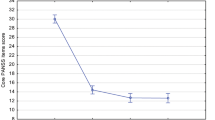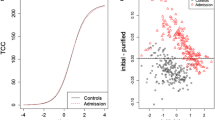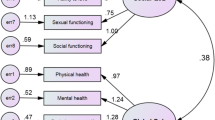Abstract
Objective
To examine the stability of treatment outcome one year after discharge from an inpatient treatment programme for adolescents with severe behavioural problems combined with psychiatric disorders.
Method
Symptom Check List-90 Revised (SCL-90 R) ratings were obtained at admission, discharge and one-year follow-up for 75 patients. Treatment outcome was determined by calculating clinically significant change on the SCL-90 R Global Severity Index (GSI) between admission and discharge. Stability of treatment outcome was determined by comparing the clinically significant changes on the GSI between admission and discharge, and between admission and follow-up.
Results
Compared to baseline, 46.7% of the patients recovered (reliable change was found and their GSI at discharge was below the cutoff point for the functional population), 20% improved (reliable change was found, but the GSI was still above the cutoff point). For the other patients no reliable change was found (12.0%) or they deteriorated (21.3%). At follow-up, compared to the base score, 52.0% recovered, 13.3% improved, 12.0% showed no reliable change, and 22.7% deteriorated. Although for the whole sample no significant change was found between discharge and follow-up, some individual patients continued to improve after discharge, while others deteriorated. Analyses show that drug usage during the follow-up period is a strong predictor for these changes.
Conclusion
The results indicated that the majority of the patients recovered or improved during treatment and this treatment outcome was relatively stable at one-year follow-up. However, in a minority of patients the treatment results deteriorated during the one-year follow-up period. Drug usage turned out to be an important predictor for this deterioration.
Similar content being viewed by others

References
Agarwalla P, Kuchenhoff J (2004) Evaluation of treatment in the psychotherapeutic day clinic Basel/Teilstationare psychotherapie. Psychotherapeut 49:261–271
American Psychiatric Association (1994) Diagnostic and statistic manual of mental disorders 4th edn. APA, Washington DC
Arrindell WA (2001) Changes in waiting-list patients over time: data on some commonly-used measures. Beware! Behav Res Ther 39:1227–1247
Arrindell WA, Ettema JHM (2003) Symptom checklist, SCL-90. Manual for a multidimensional psychopathology indicator / Symptom Checklist, SCL-90. Handleiding bij een multidimensionele psychopathologie-indicator. Swets Test Publishers, Lisse
Arrindell WA, Ettema JH, Groenman N, Brook F, Janssen I, Slaets J, Hekster G, Derksen J, Ende J van der, Land H, Hofman K, Dost S (2003) Science: the growing embedment of the Dutch SCL-90-R. Psycho-diagnostic tools/Wetenschap: De groeiende inbedding van de Nederlandse SCL-90-R. Psychodiagnostisch gereedschap. De Psycholoog 38:576–582
Bartels AAJ (2001) The social competence model and the child and youth psychotherapy: origin, meaning, state of affairs and future / Het sociale-competentiemodel en de kinder-en jeugdpsychotherapie: ontstaan, betekenis, stand van zaken en toekomst. Kinder jeugdpsychother 28:5–22
Bleichhardt G, Timmer B, Rief W (2005) Pradiktoren fur den direkten und langerfristigen Therapieerfolg bei Patienten mit somatoforen Storungen nach verhaltenstherpeutischer Behandlung / Predictors for short- and long-term outcome in patients with somatoform disorders after cognitive-behavioral therapy. Z Klin Psychol Psychiatr Psychother 53(1):40–58
Boon AE, Braeckman VC, t’ Hoen T (2001) Norm tables for the SCL-90 for adolescents / Normtabellen voor de SCL-90 voor adolescenten. Internal publication De Jutter, Den Haag
Boon AE, Colijn S (2001) Adolescents in residential psychiatric care: treatment outcome, social support and cultural background. Dissertation, Den Haag
Bruinsma M, Boon AE (2001) Orthopsychiatry, treatable youngsters? / Orthopsychiatie, [be]handelbare jongeren?. SWP, Amsterdam
De Boer SBB, Boon AE (2003) Research and quality protection of the treatment in De Fjord; centre for orthopsychiatry / Onderzoek naar en kwaliteitsbewaking van de behandeling in De Fjord; centrum voor orthopsychiatrie. Onderzoeksopzet. Internal Publication De Fjord, Capelle aan den IJssel
Cedereke M, Monti K, Ojehagen A (2002) Telephone contact with patients in the year after a suicide attempt: does it affect treatment attendance and outcome? A randomized control study. Eur Psychiatry 17:82–91
Damkroger MK (1998) A program evaluation study of a partial hospital program. Dissertation Abstracts International: Section B: The Science and Engineering 59:1846
Essau CA (2003) Comorbidity of anxiety disorders in adolescents. Depress Anxiety 18: 1–6
Geres JH, Barelds DPH, Heins RW (2002) Results of a part-time treatment for mood disorders / Resultaten van een deeltijdbehandeling voor stemmingsstoornissen. Diagnostiek-wijzer 5:72–81
Grünwald HS, Massenbach K von (2003) Effectiveness of out-patient systemic therapy–a multicenter study in the German speaking part of Switzerland / Ergebnisqualität ambulanter systemischer Therapie – Eine Multizenterstudie in der deutschsprachigen Sweiz. Psychother Psychosom Med Psychol 53:326–333
Hafkenscheid A, Kuipers A, Marinkelle A (1998) Self-rating symptom inventories in single-case treatment efficacy studies: Are the indices of “clinical significance” and “reliable change” applicable to clinical practice? / De vragenlijst als effectmaat bij “N = 1”: hoe bruikbaar zijn statistische definities van “klinische significantie” en betrouwbare verandering?. Gedragstherapie 31:221–239
Hageman JJM, Arrindell WA (1999) Establishing clinically significant change, increment of precision and the distinction between individual and group level of analysis. Behav Res Ther 37:1169–1193
Hageman JJM, Arrindell WA (1999) Clinically significant and practical! Enhancing precision does make a difference. Reply to McGlinchey and Jacobson, Hsu, and Speer. Behav Res Ther 37:1219–1233
Hahlweg K, Fiegenbaum W, Schroder B, Frank M, Witzleben I von (2004) Klinische Brauchbarkeit der Konfrontationstherapie fur agoraphobische Patienten: Einfluss von syndromaler Komorbiditat und therapeutischer Erfahrung / Clinical usefulness of high-density exposure in patients with agoraphobia: the influence of comorbidities and experience of the therapist. Zeitschrift fur Klinische Psychologie und Psychotherapie: Forshung und Praxis 33:130–138
Haley CL (2002) Acute stabilization and three-months follow-up of an inpatient trauma population. Dissertation Abstracts International: Section B: The Science and Engineering 63:527
Hansson H, Zetterlind U, Aberg-Orbeck K, Berglund M (2004) Two year outcome of coping skills training, group support and information for spouses of alcoholics: a randomized controlled trail. Alcohol alcohol 39:135–140
Hart KM, Bryer JB, Martines KA (1991) SCL-90-R symptom patterns for adolescent psychiatric inpatients. J Pers Assess 56:168–178
Hsu LM (1999) A comparison of three methods of identifying reliable and clinically significant changes: commentary on Hageman and Arrindell. Behav Res Ther 37: 1195–1202
Jacobson NS, Follette WC, Revenstorf D (1984) Psychotherapy outcome research: methods for reporting variability and evaluating clinical significance. Behav Ther 15:336–352
Jacobson NS, Truax (1991) Clinical significance: a statistical approach to defining meaningful change in psychotherapy research. J Consult Clin Psychol 59:12–19
Johnson JG, Quigley JF, Sherman MF (1997) Adolescent personality disorder symptoms mediate the relationship between perceived parental behavior and axis I symptomatology. J Personal Disord 11:381–390
Junkert-Tress B, Schnierda U, Hartkamp N, Schmitz N, Tress W (2001) Effects of short-term dynamic psychotherapy for neurotic, somatoform and personality disorders: a prospective 1-year follow-up study. Psychother Res 11:187–200
Klages U (2002) Irrational attitudes and social stress in outpatient behavior therapy: changes, prognostic and mediating influences/Irrationale Einstellungen und soziale Belastung bei Patienten in ambulanter Verhaltenstherapie: Verlauf, prognostische und mediierende Einflüsse auf den Behandlungserfolg. Psychother Psychosom Med Psychol 52:500–510
Koeter MWJ, Ormel J, Van den Brink W (1988) Total score of the SCL-90 as a measure of severity of psychopathology/Totalscore van de SCL-90 als maat voor de ernst van psychopathologie. Ned Tijdschr Psychiatrie 43:381–391
Kvarstein E, Karterud S, Pedersen G (2004) Severely disturbed borderline patients need more than a short-term day hospital treatment. Therapeutic Communities: International Journal for Therapeutic and Supportive Organizations 25:120–130
Levy KN, Becker DF, Grilo CM, Mattanah JJF, Garnet KE, Quinlan DM, Edell WS, McGlashan TH (1999) Concurrent and predictive validity of the personality disorder diagnosis in adolescent inpatients. Am J Psychiatry 156:1522–1528
Leichsenring F, Biskup J, Kreische R, Staats H (2005) The Göttingen study of psychoanalytic therapy: first results. Int J Psychoanal 86:433–455
McGlinchey JB, Jacobson NS (1999) Clinically significant but impractical? a response to Hageman and Arrindell. Behav Res Ther 37:1211–1217
McGough J, Curry JF (1992) Utility of the SCL-90-R with depressed and conduct-disordered adolescent inpatients. J Pers Assesst 59:552–563
Nevonen L, Broberg AG (2005) A comparison of sequenced individual and group psychotherapy for eating disorders not otherwise specified. Eur Eat Disord Rev 13:29–37
Olsen LR, Mortensen EL, Bech P (2004) The SCL-90 and SCL-90R versions validated by item response models in a Danish community sample. Acta Psychiatr Scand 110:225–229
Reibel DK, Greeson JM, Brainard GC, Rosenzweig S (2001) Mindfulness based stress reduction and health related quality of life in a heterogeneous patient population. Gen Hosp Psychiatry 23:183–192
Rø Ø, Martinsen EW, Hoffart A, Rosenvinge JH (2003) Short-term follow-up of severe bulimia nervosa after inpatient treatment. Eur Eat Disord Rev 11:405–417
Rø Ø, Martinsen EW, Hoffart A, Rosenvinge JH (2004) Short-term follow-up of adults with long standing anorexia nervosa or non-specified eating disorder after inpatient treatment. Eat Weight Disord 9:62–68
Ross CA, Haley C (2004) Acute stabilization and three-month follow-up in a trauma program. J Trauma Dissociation 5:103–112
Rothwe N, Duffy L (1999) Towards an integrated psychotherapeutic approach in psychosis: three case studies. Clin Psychol Psychother 6:227–235
Schauenburg H, Strack M (1999) Measuring psychotherapeutic change with the symptom checklist SCL 90 R. Psychother Psychosom 68:199–206
Speer DC (1999) What is the role of two-wave designs in clinical research? Comment on Hageman and Arrindell. Behav Res Ther 37:1203–1210
Vetrone G, Cuzzolaro M, Antonozzi I (1997) Clinical and subthreshold eating disorders: Case detection in adolescent schoolgirls. Eating Weight Disorders 1: 24–33
Vorma H, Naukkarinen H, Sama S, Kuoppasalmi K (2004) Symptom severity and quality of life after benzodiazepine withdrawal treatment in participants with complicated dependence. Addict Behav 29:1059–1065
Wetterling T, Junghanns K, Mussigbrodt H, Freyberger HJ, Dilling H (1997) Assessment of therapy outcome within the scope of quality assurance in a psychiatric clinic. A report of experiences / Erfassung der Therapie-ergebnisse im rahmen der Qualitätssicherung in einer psychiatrischen Klinik:Ein Erfahrungsbericht. Nervenarzt 68:742–751
Witherspoon ME (2003) An outcome study of theophosic ministry. Dissertation Abstracts International: Section B: The Sciences and Engineering 63:4391
Yong-Hong Z, (2004) A Study on group counseling for dispelling communication apprehension of undergraduates. Chin J Clin Psychol 12:156–157
Young JE (1990) Cognitive therapy for personality disorders: a schema-focussed approach. Professional resource press, Sarasota FL, USA
Young JE, Klosko JS, Weishaar ME (2005) Scheme based therapy: manual for therapists/Schemagerichte therapie: handboek voor therapeuten. Bohn Stafleu van Loghum, Houten
Zeeck A, Hartmann A, Kuhn K (2005) Psychotherapy in a day clinic: results of a 1.5 year follow-up. Psychiatr Q 76:1–17
Acknowledgements
We wish to thank Zita Haijer and the members of the research group for their helpful comments on an earlier draft of this paper. In particular, we would like to express our gratitude to Marike Bruinsma, for her thorough research activities in the first five years of the research project.
Author information
Authors and Affiliations
Corresponding author
Rights and permissions
About this article
Cite this article
Boon, A.E., de Boer, S.B. Drug usage as a treat to the stability of treatment outcome. Eur Child Adolesc Psychiatry 16, 79–86 (2007). https://doi.org/10.1007/s00787-006-0576-x
Accepted:
Published:
Issue Date:
DOI: https://doi.org/10.1007/s00787-006-0576-x



